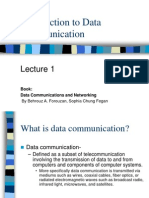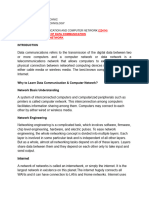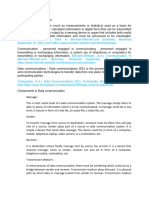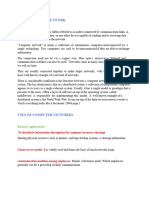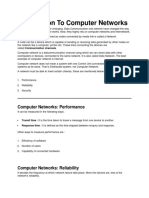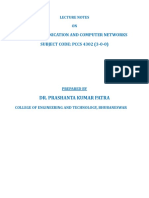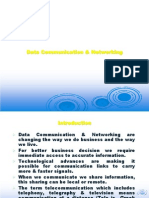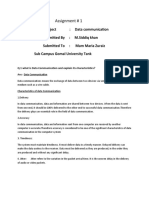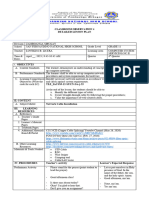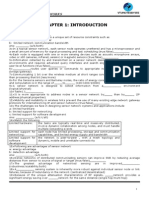Data Communication and Networking
In this constantly changing world of network technologies, data communication and networking
provides a comprehensive and current introduction to the upcoming network advancements.
TABLE OF CONTENT
• What is data?
• What is data communication?
• Characteristics of Data Communication
The article introduces the definition of data communication and computer networks. Data
communication and networking refers to the system of exchanging data or information with the
help of communication nodes connected by communication links that are capable of transmitting
or receiving data. Data communication and networking focus on enabling seamless exchange of
data or information between any two points in the world.
The concept has brought a major change in business operations and resulted in new technologies
by increasing data exchange reliability. Also, there is a book named Data Communication and
Networking by Frozen explaining four major concepts, including data communication, networking
and networking models.
What is data?
Data refers to the unsorted facts or figures collected and needs to be processed or calculated into
useful information.
What is data communication?
Data communication refers to exchanging some data between two or more devices through some
medium. It is a process of diffusing the particulars from one end and receiving the same on the
other with the involvement of some transmitting channel.
The process occurs in the presence of communicating devices combining both hardware and
software. Hardware includes the devices through which the data is sent by the sender, processed
� through the intermediate devices and the devices on which the receiver receives data. In contrast,
software involves certain specifications regarding what, when, and how to communicate.
Characteristics of Data Communication:
• Delivery: The system must convey data to the correct destination, and the concerned device or
user must receive it.
• Accuracy: There should be no alteration or falsification during the transmission so that the data
should reach accurately and with the original usable value.
• Timeless: The data should be delivered efficiently within a time interval because delayed delivery
results in no use.
• Jitter: Any discrepancies in the packet arrival time should not occur as it may affect the efficiency
of data.
Components of Data Communication
There are mainly five components of data communication and computer networks that helps in
communication between two computing devices using a network –
• Sender: A computer or any such device capable of sending data over a network is said to be a
Sender.
• Receiver: A computer or any such device capable of receiving data over a network is called a
Receiver.
• Message: Data or information in the form of texts, videos, audios, numbers, images, etc., that
needs to be exchanged between the sender and the receiver.
• Transmission Media: Any medium or link, either wired or wireless, travels from the source to the
destination.
• Protocols: In order to have productive and authentic data communication, a set of rules is needed
to be followed by both sender and the receiver.
� What are networks?
A network is the connection of a set of devices by communication links. These sets of devices are
often referred to as nodes. A node is a communication start or endpoint or any device capable of
transmitting data generated from other nodes.
What is networking?
Networking refers to the link between computing devices built on hardware and software platforms
to share the available resources. It is a web of computers that enable devices to be connected via a
network.
Data communication and Networking could be anything that makes it easier to share the data and
allows communication with different systems.
Network Criteria
The most important criteria a network needs to converge is –
• Performance: The performance can be measured in various ways and depends on various factors
like the number of users, transmission medium, hardware connection, or software efficiency.
• Reliability: The degree of a network to be accurate is determined by the recurrence of failure, time
to redeem from failure and the network’s robustness in a catastrophe.
• Security: It includes safeguarding data from unofficial access, damage and change, and devising
policies and procedures for recovery from data losses.
Categories of Networks
The category of the network is basically determined by its size. There are primarily two categories
of networks based on their size – Local Area Network and Wide Area Network. The networks of
the size in-between are referred to as Metropolitan Area Network.
• Local Area Network: Local Area Network (LAN) is usually limited to a few kilometers and is
mostly owned privately. It is distinguished from other types of networks by transmission media and
� topology. Generally, LANs use one type of transmission media. Bus, ring and star are some
common LAN topologies.
• Wide Area Network: Wide Area Network or WAN facilitates the long-distance transmission of
data or information over large geographical areas. The transmission of data, audio, videos or any
other form of information can occur worldwide.
• Metropolitan Area Networks: It is a computer network, larger than LAN but smaller than WAN,
that connects users with computer resources typically owned or managed by a single entity. It
provides high-speed connectivity and could spread over 5km to 50 km in diameter.
Conclusion:










